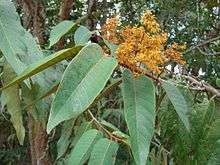Virola sebifera
| Virola sebifera | |
|---|---|
 | |
| Scientific classification | |
| Kingdom: | Plantae |
| (unranked): | Angiosperms |
| (unranked): | Magnoliids |
| Order: | Magnoliales |
| Family: | Myristicaceae |
| Genus: | Virola |
| Species: | V. sebifera |
| Binomial name | |
| Virola sebifera Aubl. | |
| Synonyms | |
Virola sebifera,also known as Myristica sebifera, common names ucuúba-do-cerrado[3] and red ucuuba,[2] is a type of tree from the family Myristicaceae, from Central America and South America[4] (Costa Rica to northern Brazil).[1] It is found in evergreen forests and savannas up to about 1,400 m (4,600 ft) in altitude.[1]
Description
Virola sebifera is a tall, thin tree which grows 5–30 m (16–98 ft) tall.[1] The leaves are simple and grow up to 30 cm (12 in) long. The small flowers are single-sexed and are found in panicles. The fruit is reddish, oval-shaped and about 10–15 mm (0.39–0.59 in) long and about 11 mm (0.43 in) in diameter.[1] The individual Virola trees, which include 40 to 60 species, are difficult to differentiate from one another.[5]
Chemical constituents
The bark of the tree is rich in tannins[4] and also the hallucinogen[6] dimethyltryptamine (DMT), as well as 5-MeO-DMT. The ripe seeds contain fatty acid glycerides, especially laurodimyristin and trimyristin. [7] The bark contains 0.065% to 0.25% alkaloids, most of which are DMT and 5-MeO-DMT.[8] The "juice or gum" of the bark seems to have the highest concentrations of alkaloids (up to 8%).[8]
Uses
Industrial uses
Seeds from Virola sebifera are processed to obtain the fats, which are yellow and aromatic. They smell like nutmeg.[9] The fats also become rancid quickly. They are used industrially in the production of fats, candles and soaps. This virola fat possesses properties similar to cocoa butter[7] and shea butter.
The wood of Virola sebifera has a density of about 0.37 g/cm3 (0.013 lb/cu in).[10]
Traditional medicine
The smoke of the inner bark of the tree is used by shamans of the indigenous people of Venezuela in cases of fever conditions, or cooked for driving out evil ghosts.[5]
Myristica sebifera, (Abbreviation: Myris) is derived from the fresh, red juice from the injured bark of the tree. It is especially used for such ailments as abscesses, phlegmon, paronychia, furuncle, anal fissures, infections of the parotid gland, bacterially infected tonsilitis, and others.[4][11][12]
See also
References
Notes
- 1 2 3 4 5 6 7 8 9 10 11 12 http://www.plantes-botanique.be/e2-Myristicaceae-Virola-venosa. Retrieved 2008-04-30. Missing or empty
|title=(help) - 1 2 Virola sebifera | Henriette's Herbal Homepage
- ↑ Estudos de áreas naturais fragmentadas
- 1 2 3 Markus Wiesenauer, Suzann Kirschner-Brouns: Homöopathie - Das große Handbuch, Gräfe & Unzer Verlag, 2007, ISBN 978-3-8338-0034-4
- 1 2 Christian Rätsch: Enzyklopädie der psychoaktiven Pflanzen. AT Verlag, 2007, 8. Auflage, ISBN 978-3-03800-352-6
- ↑ Andreas Kelich: Halluzinogene Rauschdrogen: Botanischer Teil: Virola spp.: V. sebifera
- 1 2 Karl Hiller, Matthias F. Melzig, Lexikon der Arzneipflanzen und Drogen, 2 Bände, Genehmigte Sonderausgabe für den area verlag, 2006, ISBN 3-89996-682-1
- 1 2 COMMITTEE FOR VETERINARY MEDICINAL PRODUCTS VIROLA SEBIFERA SUMMARY REPORT
- ↑ Talg, vegetabilischer. article in: Meyers Konversations-Lexikon, 4. Aufl. 1888–1890, Bd. 15, S. 499 f.
- ↑ "PUERTAS". inverhutchinson.com. Retrieved 2008-04-30.
- ↑ Homöopathisches Repetorium, Deutsche Homöopathie Union (DHU)
- ↑ Mohinder Singh Jus, Praktische Materia Medica. Arzneimittellehre von A-Z, Homöosana, 2004, ISBN 3-906407-05-5
General references
- Christian Rätsch: Enzyklopädie der psychoaktiven Pflanzen. AT Verlag, 2007, 8.te Auflage, ISBN 978-3-03800-352-6
- Karl Hiller, Matthias F. Melzig, Lexikon der Arzneipflanzen und Drogen, 2 Bände, Genehmigte Sonderausgabe für den area verlag, 2006, ISBN 3-89996-682-1
- Markus Wiesenauer, Suzann Kirschner-Brouns: Homöopathie - Das große Handbuch, Gräfe & Unzer Verlag, 2007, ISBN 978-3-8338-0034-4
External links
- Virola sebifera - Photo Gallery
- Photos of Virola sebifera
- Three photos of Talgmuskatnußbaum
- Virola sebifera Aublet
- Climate Change and the effects on Virola sebifera